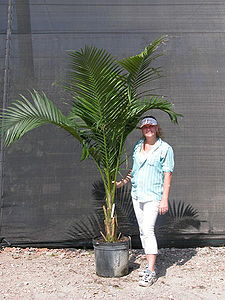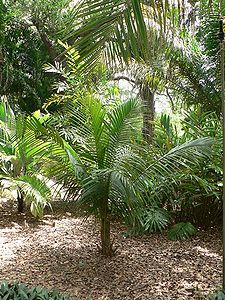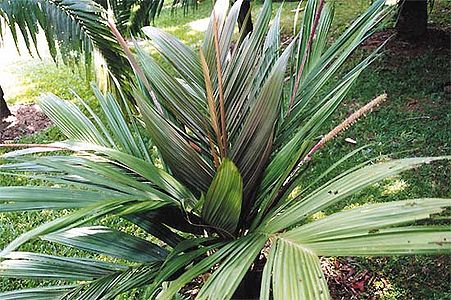Calyptronoma occidentalis
<google>CH02</google>
| Calyptronoma (ka-lip-tro-NO-mah) occidentalis (ahk-see-den-TAH-less) | |||||||
|---|---|---|---|---|---|---|---|
 Singapore Botanic Gardens. Photo by Mike Gray, edric. | |||||||
| Scientific Classification | |||||||
| |||||||
| Synonyms | |||||||
|
| |||||||
| Native Continent | |||||||
|
| |||||||
| Morphology | |||||||
| |||||||
| Culture | |||||||
|
| |||||||
| Survivability index | |||||||
|
| |||||||
| Common names | |||||||
|
| |||||||
Contents
Habitat and Distribution
Jamaica, and the West Indies, grows in swamp margins of lakes & streams.
This species is characterized by having the longest rachillae in the genus. When dry, the pit bracts are divaricating. The pollen is also distinctive. This species is tolerant of a broad range of environmental conditions. In its native Jamaica, it grows in swamps near sea level, in upland marshes (Mason River Field Station), and along mountain streams at more than 700 m above sea level. It is also the species most amenable to cultivation in southern Florida. Phenology: This species flowers in June through December; fruits have been collected throughout the year, with a peak in early spring. (S. Zona. 1995)/Palmweb.
Description
Solitary palm light brown trunk to 48' (7–12 m), tall, 1' (17–29 cm) in diameter, younger trunk covered with brown fibers, older trunks closely ringed. Editing by edric.
Stem to l5 m tall, 8.8-30 cm in diam. Leaf 2.8- 4.3 m long, with ca. 60 segments; segments 52-95 cm long, 2.1-4.5 cm wide, bearing inconspicuous multicellular trichomes on the abaxial intercostal surface. Prophyll 35.5-63 cm long, 5-8(-13) cm wide. Peduncle 39-98.5 cm long and 1-2.8 cm wide; rachillae (21-)26-35.5 cm long, 4.3-6.8 mm in diam, with (6-)7(-8) rows of pits; proximal rachillae borne in clusters of up to 3-4(-6) on stalks 0.7-4,I cm long, 0.5-0.9 cm wide, clustered rachillae borne for ca. 1/2 the length of the rachis; pits 1.7-4.1 mm long, 1.8-3.6 mm wide, longitudinal distance between pits (lip to lip) 4.2-9.8 mm. Staminate flowers 5-5.9 mm long; sepals 3.3-4.4 mm long, 0.9-1.1 mm wide; petals 3.5-5.7 mm long, 1.1-2.2 mm wide; staminal tube 3-5 .2 m, anthers 1.1-1.6 mm long. Pistallate flowers 4.9-6.5 mm long; sepals 3.4-4 mm long, 1-1.3 mm wide; corolla not seen; staminode not seen; glmoecium ca.6.7 mm long, style ca. 5.1 mm long; ovary 1-1.2 mm long. Fruit 9.8-15.8 mm long, 5.9-8.5 mm in diam.; endocarp free from seed, strongly net-like; seed (5.1 -)5.8-8.6 mm long, (3.9-)4.4-5.8 mm diam. (S. Zona. 1995)/Palmweb.
The type of C. swartzii was given by Grisebach (1864, I866) as Wright 1466; however, Swartz's Elaeis occidentalis of specifically cited as a synonym. In the 1864 publication of the genus name, Grisebach wrote that this genus was "construeted upon the Elaeis occidentalis Sw." Thus, the name C. swartzii is nomenclaturally superfluous, and the type of C. swartzii must be the type of E. occidentalis. No Swartz collections of E. occidentalis have been found at BM, G, LD, S, S-Linn, or SBT (T. Zanoni, pers. comm.), hence, a neotype is designated here. Although three collections were cited by León (1944) in the publication of Calyptrogyne victorinii, I consider the specimen annotated by León to be the holotype. (S. Zona. 1995)/Palmweb.
Culture
Very rarely seen in cultivation. requires a Warm, sheltered, environment, and lots of moisture.
Comments and Curiosities
Uses: Leaves are used for thatch, and stems are used for construction. (S. Zona. 1995)/Palmweb.
External Links
References
Phonetic spelling of Latin names by edric.
Special thanks to Geoff Stein, (Palmbob) for his hundreds of photos, edric.
Special thanks to Palmweb.org, Dr. John Dransfield, Dr. Bill Baker & team, for their volumes of information and photos, edric.
Glossary of Palm Terms; Based on the glossary in Dransfield, J., N.W. Uhl, C.B. Asmussen-Lange, W.J. Baker, M.M. Harley & C.E. Lewis. 2008. Genera Palmarum - Evolution and Classification of the Palms. Royal Botanic Gardens, Kew. All images copyright of the artists and photographers (see images for credits).
Zona, S.1995. A Revision of Calyptronoma (Arecaceae). Principes 39: 140-151.
- IMAGE GALLERY
Many Special Thanks to Ed Vaile for his long hours of tireless editing and numerous contributions.







